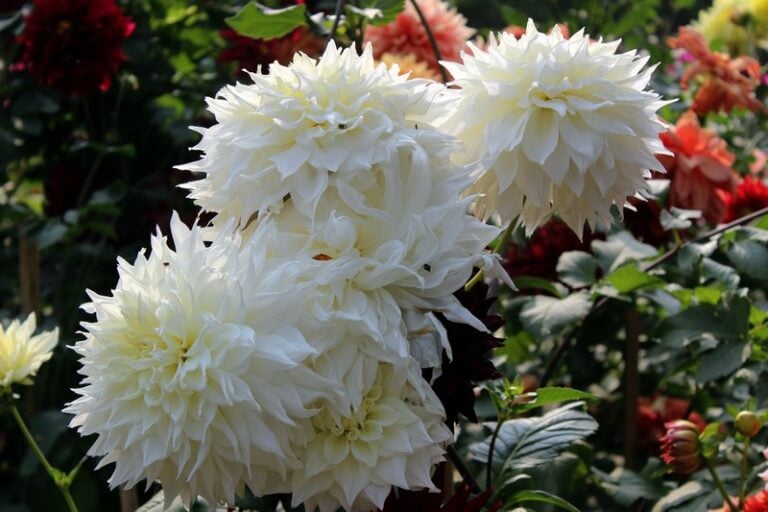Give Your Garden a Burst of Color With a Celosia
Celosia plants produce dramatic, colorful flower heads. The shape of the flower heads depends on the variety. Some are tall and spiky, others are twisted and wavy. No matter which type of celosia you grow, the plant needs a few things to do well. It’s grown as annual and won’t tolerate frost or cold. You’ll want to wait until after the danger of frost is past to plant it in your garden. The plant needs full sun, consistent moisture and regular feedings to thrive. It also needs plenty of space to spread out and
Types of Celosia
Celosia plants are members of the Amaranthaceae or amaranth family. They have a number of similarities with other members of the family, particularly when it comes to their showy, fluffy flower plumes. Although there are lots of different varieties of celosia plant, it can be grouped into two major categories, according to Texas A&M University.
The plumed variety have the tall, multi-flowered spikes. Each spike looks soft and feathery and contains hundreds of little flower buds. Depending on the exact variety of celosia, those spikes might be vibrant red in color, bright orange, sunny yellow or a deep purple.
In Greek, “celosia” means “burning,” and the tall, vibrant plumes of the plants often resemble a fire, especially when several are planted together. Occasionally, the plant is known as coxcomb or woolflower, because of the appearance of the flower plumes.
Cristata, or crested, is the other variety of celosia. While the plumed variety has towering flower spikes, the crested variety has even more unique looking blooms. Some would describe the texture and shape of a crested celosia plant’s flowers as resembling the wiggles and waves of the brain. The crested flowers can be up to 18 inches long, depending on the specific plant variety.
Planting Celosia
Celosia is grown as an annual plant in zones 2 through 11. It doesn’t tolerate cold and won’t make it through a frost. You can start the plant from seeds or seedlings.
If you are going to start with seeds, plant them indoors about four weeks before the last frost in your area. Plant several seeds in one pot, about 1/4 inch deep. Let them germinate, covered in plastic wrap, in a spot that is at least 70 degrees Fahrenheit.
Put the baby seedlings under a fluorescent light once they have emerged. Place the lights about six inches above the plant. As the seedlings continue to grow, thin them out, so that you have just a single plant per pot. Choose the plant that looks the healthiest.
Once the danger of frost has past, you can plant the celosia in the garden. The plants can get quite large and need a good amount of airflow around them, so don’t crowd them. Leave at least 10 inches of space on all sides if you’re growing a smaller variety or at least 16 inches on all sides for larger plants.
It takes celosia about 90 days to produce flowers after you plant them. That means you can direct sow in the garden if you live in a warmer area that has a long summer. To direct sow, wait until after the last frost. Spread the seed across the soil, planting it a half in deep. Thin the plants to stand either 10 or 16 inches apart (based on size) after the seedlings have at least one set of true leaves.
You often find celosia seedlings for sale at garden centers. Planting those can be an easy way to add color to your garden, but there is something you need to be aware of. Celosia planted in tiny cells and sold at nurseries often have stunted growth, according to Cornell.
The roots of the plants can get crowded in the cells and stop growing. If that occurs, the plant will not develop or grow very much once you plant it in the soil.
The video above from eHow Garden gives you a quick rundown of the basics of planting celosia, including when the best time to plant is.
Care for Celosia
Like most plants, celosia needs light, water and food to survive. Since the plant produces such as large, vibrant flowers, it needs full sun to really reach its full potential. Whether you plant in a container or in the ground, choose a location that gets at least eight hours of sun each day. In a shadier location, you won’t get much in the way of blooms.
Your celosia plants will also need fairly consistent levels of moisture to thrive in the garden. You want to keep the soil moist throughout their growing season. But you also want to be careful not to give the plants too much water.
Problems such as powdery mildew or fungal leaf spot can occur if the plants are in too-moist conditions. Those diseases can also happen if the plants are too close together and there isn’t enough air circulation.
When it’s growing, celosia is going to need to be fed at least once a month. You can mix a handful of compost into the soil by plants or use a balanced fertilizer to make sure the plant is getting the nutrition it needs.
The Next Generation of Celosia
All those little flower buds on celosia mean one thing: the plant is capable of producing lots and lots of seeds.Although celosia isn’t an invasive plant, it is very good at self-seeding. If you plant celosia one year, you might get a few surprise new plants in your garden the next.
If you’d like to control where celosia grows and the number of plants you end up growing, you need to harvest the flower heads before they dry out. The video from Oklahoma Gardening walks you through the process of collecting the flower heads and drying them, so that you can save seeds to plant the next year.

